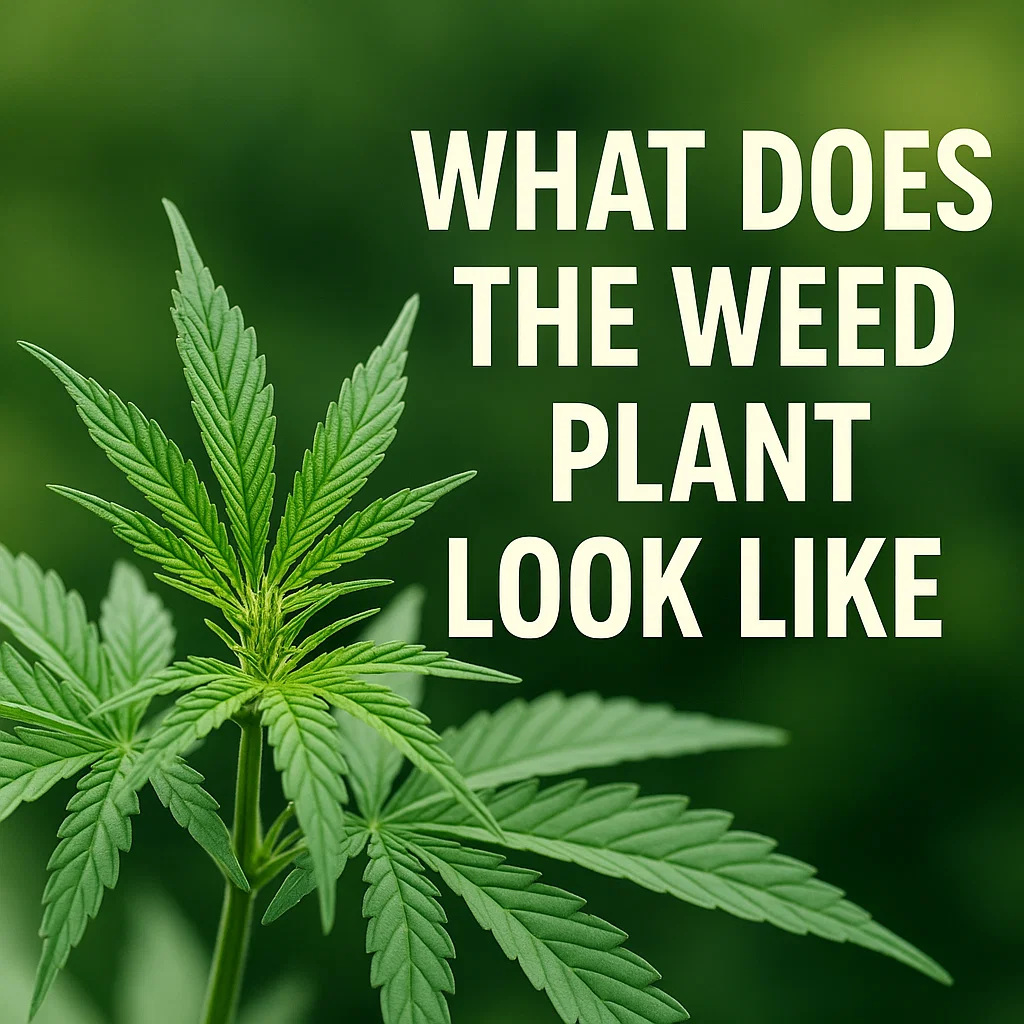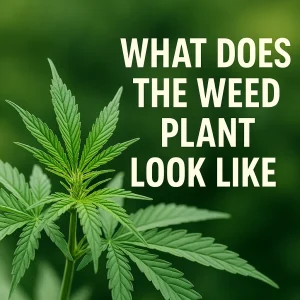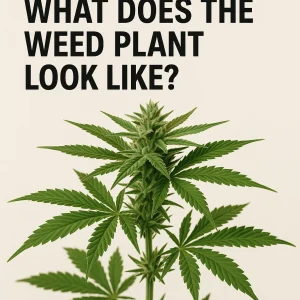What Does the Weed Plant Look Like?

What Does the Weed Plant Look Like? A Clear, Hands-On Field Guide
You’ve seen jars, pre-rolls, and cured buds—but what does the weed plant actually look like from seedling to harvest? Once you know the visual cues, you can spot healthy cannabis in seconds, read the plant’s mood at a glance, and even estimate where it sits in the growth cycle. This guide walks you through each stage and body part in plain language, with the kinds of details growers and curious shoppers care about.
If you want to compare plant traits to finished flower, browse our live shop for strain notes and photos. For quick answers about ordering, the FAQ is always available.
The Big Picture: Cannabis at a Glance
A cannabis plant is a sturdy, aromatic annual with a central stem (or several, if it’s been topped), wide palmate leaves (think hand-shaped), and distinct nodes where branches and leaves emerge. Depending on the variety and how it’s grown, the plant can be a compact bush or a tall, spear-shaped tower. Near the end of the season, sticky trichomes sparkle across the flower clusters, and delicate pistils—the hair-like stigmas—shift color from white to orange, amber, or pink.
Key traits you’ll notice in healthy plants:
-
Leaves arranged like fingers from a palm, with serrated edges
-
Clearly defined nodes along a thickening stem
-
A shape that becomes either bushy (trained) or columnar (untouched)
-
Increasing aroma as resin glands develop in bloom
Let’s break that down part by part.

Vegetative stage: fresh growth and sharp serrations.
Anatomy 101: Parts You’ll Recognize on Sight
Leaves: The Icon Everyone Knows
The classic leaf is palmate—five to nine narrow leaflets radiating from a single point. Edges are jagged like a saw. Sativa-leaning plants often display longer, thinner leaflets; indica-leaning plants tend to carry broader leaflets with deeper green. New seedlings start with simple oval cotyledons, then steps up to three-blade leaves, eventually hitting five, seven, or nine blades in vegetative growth.
What leaves tell you:
-
Color: Vibrant green signals balanced nutrition; pale or yellowing can mean a nitrogen shortfall or natural fade late in flower.
-
Posture: Leaves that “pray” upward often enjoy strong light; droopy leaves may indicate overwatering or root stress.
-
Texture: A taut, slightly waxy feel fits healthy plants; crispy margins suggest heat or salt buildup.
Stems and Nodes
The main stem carries the plant’s weight. Strong, slightly woody stems by late veg are a good sign. Nodes are the intersections where leaves and side branches emerge; they’re also where pre-flowers first appear. Internode spacing (the distance between nodes) shortens under bright light and lengthens when a plant stretches toward a dim source.
Roots (Mostly Hidden)
You won’t see them unless you up-pot, but healthy roots are white to cream and smell earthy. Brown, slimy roots with off odors indicate rot. Above ground, root health shows up as steady turgor (firm leaves) and balanced growth.
Flowers: Calyx, Pistils, and Trichomes
The “buds” you grind later are tight clusters of calyxes—small tear-shaped structures that stack into colas. Pistils are the hair-like stigmas that catch pollen; they begin white and gradually darken. Trichomes are the tiny resin glands that look like frost or sugar dusting; under magnification they resemble glass lollipops. As these swell and turn cloudy, the plant is nearing peak ripeness.
Growth Stages: What the Plant Looks Like Over Time
1) Seedling (Week 1–2)
-
Height/shape: Two small round cotyledons, then a three-blade leaf.
-
Color: Bright lime to medium green.
-
Look-for: Short internodes and a sturdy little stem. Seedlings that stretch very tall are chasing light.
2) Vegetative Growth (Weeks 3–8+ depending on method)
-
Height/shape: Speedy vertical growth with new nodes every few days. A happy vegging plant looks like a small, symmetrical tree or a trained bush.
-
Leaves: Five to nine blades, deepening green, bigger by the week.
-
Smell: Slightly herbal; not yet the full strain aroma.
-
Notes: Growers sometimes top the plant (cut the main tip) to create two or more leading branches, resulting in a broad, flat canopy that supports multiple colas later.
3) Pre-Flower (About 1–2 weeks after flip or late summer outdoors)
-
Look: At the nodes, tiny structures appear. On females you’ll see a small teardrop with two white hairs (pistils) peeking out. On males you’ll see ball-shaped sacs without hairs.
-
Why it matters: Most home growers keep females for seedless buds and remove males unless they’re breeding.
4) Flowering—Early (Weeks 1–3 of bloom)
-
Look: White pistils tuft up along the branch tips. The plant stretches—sometimes doubling in height. Leaves are still broad and healthy.
-
Aroma: Increases noticeably. Touch a sugar leaf and your fingers pick up the first sticky resin.
5) Flowering—Mid (Weeks 4–7)
-
Look: Buds fatten as calyxes stack. Sugar leaves (small leaves within the bud) frost over with trichomes. Stems thicken to support weight. Pistils are mostly white but some begin to darken.
-
Aroma: Now the plant smells like the strain description—citrus-diesel for a Sour D type, vanilla-sweet for a Pink Kush, sharp gas for jet-fuel lines. If you want to taste those profiles in finished form, compare our Sour Diesel Small AAA and Premium Pink Kush Indica product notes.
6) Flowering—Late / Ripening (Final 1–3 weeks)
-
Look: Many pistils curl and darken; calyxes swell; trichomes turn from clear to cloudy, then some to amber. Fan leaves may fade from green to yellow, purple, or red depending on genetics and temperature.
-
Clue for timing: A field loupe shows most trichomes cloudy with a scatter of amber—classic “ready soon” signal. The plant looks heavy and fragrant.
Male, Female, and Hermaphrodite: Visual Differences
-
Female plants produce the buds most people are after. You’ll clearly see pistils at nodes and later in dense clusters.
-
Male plants grow taller with thicker branching and develop clusters of small round pollen sacs that hang like tiny grapes.
-
Hermaphrodite plants show both sex traits—usually female flowers with a few male sacs or “bananas.” If you see these, most growers remove or isolate the plant to avoid accidental pollination.
In a mixed garden, sex becomes obvious by pre-flower. In clone gardens, all plants are typically female copies.
Leaf and Cola Shapes by Heritage
While hybridization blurs the lines, you can still recognize broad patterns:
-
Sativa-leaning plants often stand taller with long limbs, narrower leaflets, and airy, speared colas. They can look feathery and elegant.
-
Indica-leaning plants are shorter and bushier with wide leaflets and dense, chunky colas that look like stacked golf balls.
-
Hybrids split the difference: stout frames with elongated colas, or tall frames with surprisingly dense buds.
Color also shifts by cultivar and environment. Deep forest green is common in veg. In bloom you may see lime tips on new growth, dark green mature leaves, and—on some genetics—purples, blues, or even black hues after cool nights.
What Healthy vs Stressed Plants Look Like
You can read a plant like a mood ring.
Healthy
-
Leaves flat or slightly praying upward
-
Even spacing between nodes
-
Stems that feel firm; branches hold their own without drooping
-
New growth vibrant, not twisted
Underwatered
-
Whole plant droops uniformly; leaves look thin and tired; perk up soon after watering.
Overwatered
-
Droop persists and leaves feel heavy or swollen; lower leaves may yellow; pot feels consistently wet.
Heat or light stress
-
Leaves taco upward; edges crisp; top growth bleaches near overly intense lights.
Nutrient issues
-
Pale leaves with dark veins (magnesium), burnt tips (excess salts), rust spots (calcium). The plant tells you what’s off through color and pattern.
Pest pressure
-
Small white stippling (mites), leaf curls (aphids), or webbing near new growth. A healthy plant still looks vigorous, but leaves may show specific damage patterns.
The better you know what cannabis should look like on a good day, the faster you’ll spot anything off.
Indoor vs Outdoor: Shape and Texture Changes
Indoor plants, under fixed lights and in calm air, often grow compact and sculpted. Buds finish dense and uniform; trichomes appear thick and glassy under LED lighting. Leaves stay a consistent color except for planned fades.
Outdoor plants catch real sun and breeze. They can tower head-high or more, with rugged branching. Buds may show more variation across the plant: top colas dense, lower buds slightly airier. Sun-grown resin can look glittery in daylight, and late-season color changes are common as nights cool. Outdoor plants also broadcast aroma further—walk downwind and you’ll know exactly what’s in bloom.
Smell and Touch: “What It Looks Like” Beyond Sight
A complete picture isn’t just visual. Cannabis feels and smells a certain way at each stage:
-
Veg: Leaves feel firm and springy; stems snap clean when pruned. The scent is green and herbal.
-
Mid flower: Buds feel sticky to the touch; sugar leaves coat your fingers with resin. The scent is now distinct—citrus, pine, cream, gas, berry, bakery spice, or garlic depending on genetics.
-
Late flower: Calyxes firm up; sticky becomes tacky; a light press leaves a floral fingerprint. Aroma is unmistakable and lingers.
If you enjoy the gassy, high-octane lane, the look and smell of cultivars like Purple Jet Fuel—dense, resinous colas with a metallic, fuel-forward nose—are textbook examples.
After Harvest: Recognizing Well-Cured Bud
You asked what the plant looks like, but most people meet cannabis in the jar. Well-grown flower carries visual signatures that mirror the live plant:
-
Bud structure: Tight but not rock-hard; calyxes visible; sugar leaves trimmed close.
-
Trichomes: A frosty blanket with intact heads, not smeared to dust.
-
Color: Natural greens and purples with orange/brown pistils; no neon oversaturation or dull browns from age.
-
Ash and burn: Clean, even cone; ash light gray to white. (That finish reflects careful drying and curing more than looks alone.)
For a refresher on preserving that quality once you buy it, see our guide on how to keep weed fresh in the blog.
Recognizing Different Plant Training Looks
Modern home gardens shape plants to maximize light and airflow. The plant’s look tells you which method was used:
-
Topped/Manifolding: One trunk becomes several equal leaders; the canopy looks like a flat dinner table of colas.
-
Low-Stress Training (LST): Branches are gently tied outward; the plant spreads like a wheel with many evenly tall branches.
-
Sea of Green (SOG): Many small plants, each with a single main cola, creating a uniform forest of spears.
-
Screen of Green (ScrOG): Branches woven through a net; flowers rise through a flat mesh, all at the same height.
These shapes don’t change the species—you’re still seeing cannabis—but they change the silhouette dramatically.
Color Changes: What’s Normal, What’s Not
-
Late-season purple on leaves and even buds is often genetic, especially with cool nights.
-
Uniform yellowing in late bloom is a natural fade as the plant draws nutrients from fan leaves.
-
Blotchy yellow with green veins mid-grow suggests magnesium deficiency.
-
Brown crisp tips across many leaves usually indicates nutrient excess (“tip burn”).
-
Random white patches on leaves can be powdery mildew; on buds, it’s a serious red flag.
If you ever question whether you’re seeing natural fade or a problem, context helps: timing (late vs early), location (lower fans vs new growth), and the plant’s overall vigor.
What a Ready-to-Harvest Plant Looks Like
Think full, heavy, aromatic, and slightly “finished” rather than still building.
-
Pistils: A majority have curled and darkened; not all, but many.
-
Calyxes: Plump and defined; the bud looks rounded, not stringy.
-
Trichomes: Mostly cloudy with some amber when viewed under a loupe.
-
Fan leaves: Beginning to fade; plant diverts energy to flowers.
-
Posture: Branches bow slightly under weight; stakes or nets help hold colas upright.
If you’re curious how timing affects the final feel, taste a classic pair: an energetic batch such as Sour Diesel Small AAA pulled at mostly cloudy, versus a restful batch like Premium Pink Kush Indica allowed a touch more amber. The look in the garden foreshadows the experience in the bowl.

Classic cannabis silhouette: palmate leaves and a stacking cola.
Quick Photo Checklist: “Is That a Weed Plant?”
When you’re scanning a garden or a photo and wondering what you’re seeing, run this simple test:
-
Leaf shape—hand-like with 5–9 serrated “fingers”?
-
Opposite or alternating nodes along a stout central stem?
-
Aroma that’s herbal in veg, then loud and strain-specific in bloom?
-
Flower clusters with visible pistil hairs and a frosty coat of trichomes as bloom progresses?
-
Overall silhouette of a bush or spear with repeating leaf patterns?
Hit four out of five and you’re almost certainly looking at cannabis.
From Plant to Jar: Connecting the Dots
Knowing what the plant looks like helps you read the finished product. Dense, golf-ball colas on a squat plant often translate to compact, chunky nugs in the bag. Long spears produce tapering buds with airy tips and explosive aroma. A thick frost in the garden becomes that glistening coat in the jar. Fades and colors carry through as purples and deep greens in cured flower.
If you want to compare those visuals to real products, sample a classic daytime jar and an evening counterpart from our menu. You can start with the bright profile of Sour Diesel Small AAA and the creamy calm of Premium Pink Kush Indica, then explore something gassier like Purple Jet Fuel for weekend sessions. Rotate a couple of strains and your eye will get sharp quickly.
Final Take
A weed plant is easy to recognize once you’ve met it at every stage: the hand-shaped leaves with saw-tooth edges, the ladder of nodes up a sturdy stem, the switch from herbal green in veg to loud citrus, cream, or gas in bloom, and finally the sparkling trichomes frosting over swelling calyxes as harvest approaches. With that picture in your head, jars in the shop stop being abstract names and start feeling like snapshots from a living garden.
When you’re ready to connect plant traits to flavor in the bowl, explore the current drops in our shop. And if you’ve got follow-up questions about strains, storage, or anything else, the FAQ and our team on the contact page are here to help.

